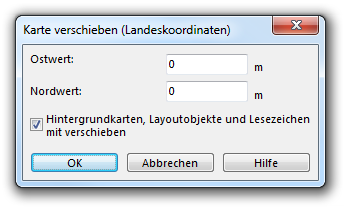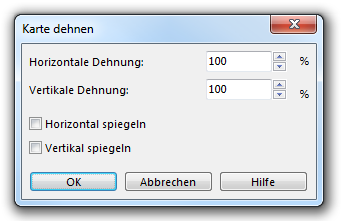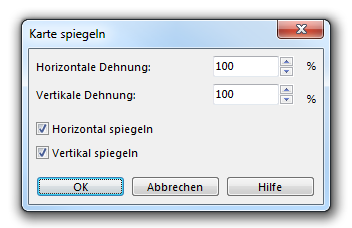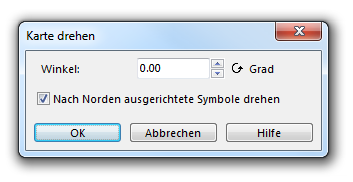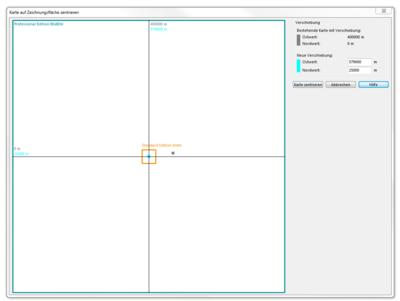Karte transformieren: Unterschied zwischen den Versionen
FBO (Diskussion | Beiträge) (→Move) |
FBO (Diskussion | Beiträge) |
||
| Zeile 12: | Zeile 12: | ||
===Stretch or Shrink=== | ===Stretch or Shrink=== | ||
The '''Stretch/Shrink Map''' dialog opens. | |||
[[File:StretchShrink.PNG]] | [[File:StretchShrink.PNG]] | ||
Enter a percentage value for the horizontal strech/shrink and the vertical stretch/shrink. If both values are the same, the proportions of the map are kept.<br /> | |||
Check the corresponding boxes if you want to reflect the map horizontally or vertically.<br /> | |||
Click the '''OK''' button when you are finished. | |||
===Mirror=== | ===Mirror=== | ||
Version vom 13. Juni 2012, 12:36 Uhr
Select the Transform item in the Map menu to choose one of the following functions.
Move
The Move Map dialog appears. Depending on wheter you are using paper coordinates or real world coordinates you can enter different values.
With set paper coordinates enter a X and a Y value in mm. By clicking the OK button the map is moved in the desired direction.
With set real world coordinates enter a value in m for easting and northing. By clicking the OK button the map is moved in the desired direction.
Check the corresponding option to move also Background Maps, Layout Objects and Bookmarks.
![]() Do not use this dialog to change the real world coordinate offset if the map is geo-referenced. To move a geo- referenced map, use the Center Map to Drawing Area function in the Transform submenu of the Map menu and enter the new offset.
Do not use this dialog to change the real world coordinate offset if the map is geo-referenced. To move a geo- referenced map, use the Center Map to Drawing Area function in the Transform submenu of the Map menu and enter the new offset.
Stretch or Shrink
The Stretch/Shrink Map dialog opens.
Enter a percentage value for the horizontal strech/shrink and the vertical stretch/shrink. If both values are the same, the proportions of the map are kept.
Check the corresponding boxes if you want to reflect the map horizontally or vertically.
Click the OK button when you are finished.
Mirror
Rotate Map
Change Coordinate System
Affine
Choose this command to adjust the whole map on background map or on grid. With this function you can geo-reference the map. The grid button must be pressed to see the grid. You can use 1 to 12 points for the adjustment. For each point you do the following:
- Mark a point on map.
- Mark the same grid point on reference (background map or grid.
When you have adjusted enough points, press the Enter key on the keyboard. The map is rotated and stretched (Affine transformation) to get the best fit for the adjustment points. You can achieve a precise adjustment with 4 adjustment points arranged in a rectangle. This way you can compensate rotation and distortion. The horizontal and vertical scales will be adjusted individually.
Rubbersheeting
ToDo Pic
Choose this command to adjust the map or a part of the map to a geo-referenced background map. The Rubbersheeting Transformation dialog box appears.
- Define rubbersheeting perimeter: Click the Define button and define the perimeter by drawing a polyline on the map. To define a new rubbersheeting perimeter click the Remove button to remove the actual one.
- Rubbersheeting settings: Choose if objects with a protected symbol and layout objects should be transformed too.
- Add rubbersheeting points: Click the Add button first and then click 2x on the map for each point:
- (1) Mark a point on the map.
- (2) Mark the same point on the reference map. The rubbersheeting points are shown on the map by a red and a green cross and a connection line.
- 4. Calculate transformation: Calculate the rubbersheeting transformation: Click the Transform button.
 -Click the Undo button in the Standard Toolbar if you are not satisfied with the rubbersheeting transformation.
-Click the Undo button in the Standard Toolbar if you are not satisfied with the rubbersheeting transformation.
- -Uncheck rubbersheeting points in the Used column if they should not be included in the transformation. Unchecked rubbersheeting points appear in gray color on the map.
- -The rubbersheeting perimeter defines that only objects or vertices of objects within this perimeter are transformed. But it is possible that objects or vertices of objects are moved out of the perimeter by the transformation! Place rubbersheeting point pairs with the same position on the perimeter border to avoid this.
Center Map to Drawing Area
Choose Transform -> Center Map to Drawing Area in Map menu to move a geo-referenced map.
This function is often used to center a map drawn in OCAD Professional edition into the smaller drawing area from OCAD Standard or CS edition. OCAD moves the map offset, all objects, all background maps and all bookmarks. After this function the map is still geo-referenced. In the dialog the extent with the existing map offset is shown in grey, the extent with the new offset in blue. The green rectangle shows the drawing area of OCAD Professional edition (80x80m), the orange the drawing area from Standard edition (4x4m). If a map should be visible in all OCAD editions then the entire map must fit in the 4x4m drawing area.
